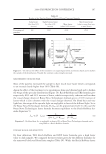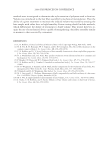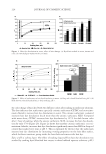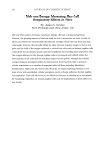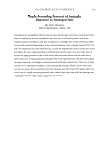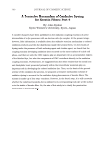JOURNAL OF COSMETIC SCIENCE 174 (Mw = 3,000,000 Da). Unless otherwise indicated, all samples were prepared as 1% solu- tions (w/w) and applied to hair with a pipette or a hairspray pump applicator. HIGH HUMIDITY AND FORCE DEFORMATION All experiments were conducted in a laboratory with humidity and temperature control (25°C and 50% RH). For high humidity experiments, hair samples were placed in a hu- midity chamber at 90% RH. Force deformation of hair samples was carried out with a texture analyzer (Model TA-XT2, Texture Technologies Corporation), Which was located inside the humidity chamber. The texture analyzer has a load sensitivity of 0.1 g and was operated using XTRA dimension 3.7 software from Stable Micro Systems. RESULTS AND DISCUSSION Hair volume measurements were carried out utilizing an in-house designed laser stere- ometer. As already stated, the stereometer was constructed utilizing a laser device, based on the principle of laser triangulation, in conjunction with a two-dimensional translation stage. The laser device sensor head is capable of measuring the distance from the laser source to an object of interest. Therefore, by placing an object such as hair on the transla- tion stage, we were able to obtain z-data for each x- and y-coordinate of a scan. Utilizing this approach, a hair tress may be positioned on the platform of the translation stage and a surface plot corresponding to the three-dimensional volume occupied by the hair as- sembly may be constructed. In addition, data are also presented in the form of contour plots or cross-sectional representations of the hair tress allowing one to view the tress along its primary axis. In an attempt to differentiate the shape between hair samples, we analyzed hair of varying degrees of curvature (straight, very curly, and frizzy) to deter- mine the occupied volume of each hair type. We also investigated the effect of bleaching and subsequent treatment on the fi ber assembly properties of European dark brown hair. Further, we studied the effects of various polymeric treatments on the volume of hair fi ber assemblies. This was accomplished by employing several different techniques to build volume into the hair fi ber assembly, then to subject hair to challenge tests, such as high humidity or external forces, and measure how well the hair fi ber-polymer assembly per- forms to induced stress. MEASUREMENT OF HAIR ASSEMBLIES WITH DIFFERENT GEOMETRIC ARRANGEMENTS Traditionally, straight hair tresses have been utilized for research and development work in the personal care industry, mostly European dark brown hair. In more recent years, hair suppliers have begun to offer hair types with various fi bers assembly properties. Some examples of these hair types are shown in Figure 2 and are classifi ed as straight, very curly, and frizzy hair. The three-dimensional geometric arrangements in these hair types are dramatically different from each other and from traditional straight hair tresses. As a result, the occupied volume by such a fi ber assembly is also very different. For the hair types shown in Figure 2, we also provide a corresponding surface plot for a section of each tress (See Figure 3). The calculated volume for each tress section is: straight–123.04, very curly–276.32, and frizzy–514.97 (values reported as cm3). The corresponding weights of
2008 TRI/PRINCETON CONFERENCE 175 the entire tresses were: straight–2.0 g, very curly–1.9 g, and frizzy–4.8 g. It is important to note that while mass is reported for the entire tress, volume is provided only for a 40 mm × 80 mm section. EFFECT OF BLEACHING ON FIBER ARRANGEMENT Bleaching is generally thought to increase the body of hair. Most likely, this is due to in- creased friction or adhesion between the fi bers as a result of bleaching in which spot welds are formed between multiple fi bers on a human head of hair. As a result, a three-dimensional structure is produced that contains voids of air due to the random nature of the spot welds and lends to an overall increase in volume. Utilizing the technique outlined in the Methods and Materials section, the effect of bleaching on fi ber assembly behavior may be moni- tored with the three-dimensional laser stereometer. A comparison was made between virgin dark brown hair and the same hair type that had undergone bleaching. The virgin hair was washed twice with 3% ALS followed by thor- ough rinsing. While still in the wet state, two fi ngers (middle and index) were run along the hair tress removing excess water and maintaining the fi bers bound together in a mat arrangement. The hair was then allowed to dry overnight on a hanging rack without Figure 2. Photograph of various hair tress geometries with numeric scale.
Purchased for the exclusive use of nofirst nolast (unknown) From: SCC Media Library & Resource Center (library.scconline.org)














































































